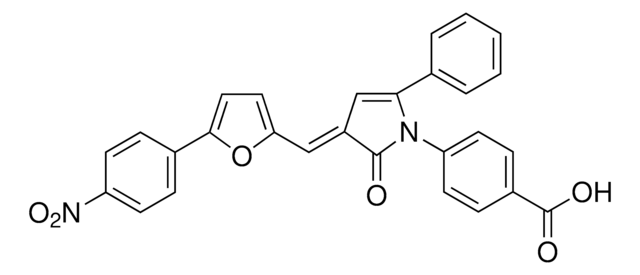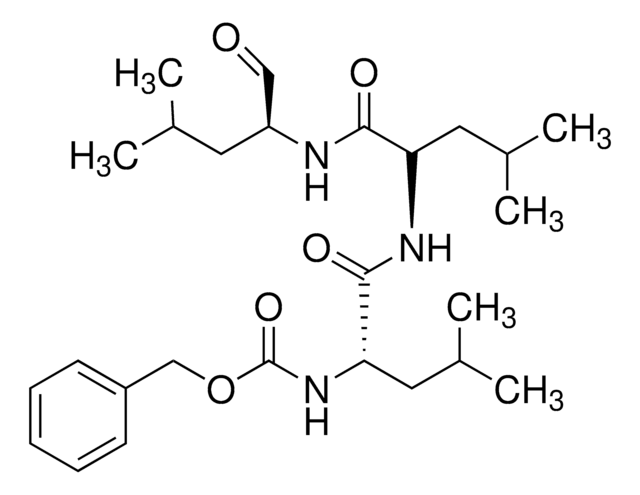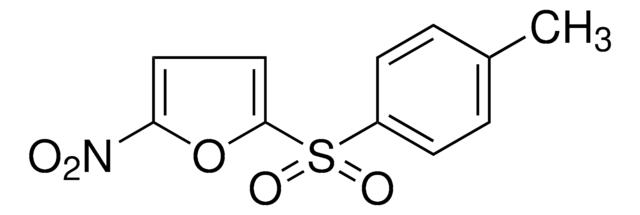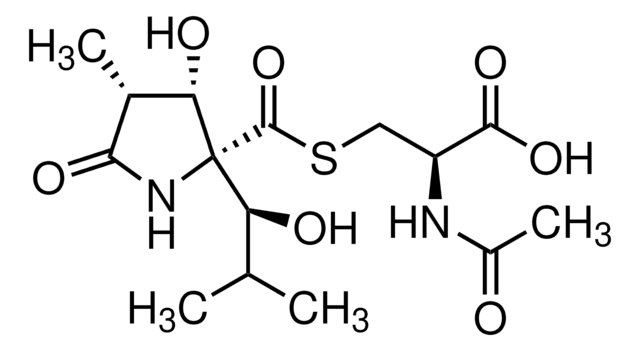SML1599
VR23
≥98% (HPLC)
Synonym(s):
7-Chloro-4-(4-(2,4-dinitrophenylsulfonyl)piperazin-1-yl)quinoline, 7-Chloro-4-[4-[(2,4-dinitrophenyl)sulfonyl]-1-piperazinyl]-quinoline, VR-23
Sign Into View Organizational & Contract Pricing
All Photos(1)
About This Item
Empirical Formula (Hill Notation):
C19H16ClN5O6S
CAS Number:
Molecular Weight:
477.88
UNSPSC Code:
12352200
NACRES:
NA.77
Recommended Products
Quality Level
Assay
≥98% (HPLC)
form
powder
color
white to beige
solubility
DMSO: 20 mg/mL, clear
storage temp.
2-8°C
Biochem/physiol Actions
Proteasomes are responsible for the cleavage of peptides in an ATP/ubiquitin-dependent manner.
VR23 is a potent inhibitor of proteasome that primary targets β2 of the 20S proteasome catalytic subunit. VR23 selectively induces apoptosis to cancer cells via cyclin E–mediated centrosome amplification. VR23 exhibit little effect on noncancerous cells.
Signal Word
Warning
Hazard Statements
Precautionary Statements
Hazard Classifications
Acute Tox. 4 Oral
Storage Class Code
11 - Combustible Solids
WGK
WGK 3
Flash Point(F)
Not applicable
Flash Point(C)
Not applicable
Certificates of Analysis (COA)
Search for Certificates of Analysis (COA) by entering the products Lot/Batch Number. Lot and Batch Numbers can be found on a product’s label following the words ‘Lot’ or ‘Batch’.
Already Own This Product?
Find documentation for the products that you have recently purchased in the Document Library.
Sheetal Pundir et al.
Cancer research, 75(19), 4164-4175 (2015-08-05)
The proteasome is clinically validated as a target for cancer therapeutics. However, proteasome-inhibitory agents that are cancer selective have yet to be developed. In this study, we report the identification of a safe and effective proteasome inhibitor with selective anticancer
G Munkácsy et al.
British journal of cancer, 102(2), 361-368 (2009-12-17)
To date individual markers have failed to correctly predict resistance against anticancer agents in breast cancer. We used gene expression patterns attributable to chemotherapy-resistant cells to detect potential new biomarkers related to anthracycline resistance. One of the genes, PSMB7, was
Our team of scientists has experience in all areas of research including Life Science, Material Science, Chemical Synthesis, Chromatography, Analytical and many others.
Contact Technical Service








